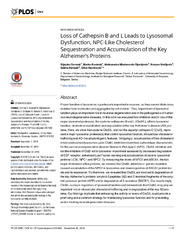Приказ основних података о документу
Loss of Cathepsin B and L Leads to Lysosomal Dysfunction, NPC-Like Cholesterol Sequestration and Accumulation of the Key Alzheimer's Proteins
| dc.creator | Cermak, Stjepko | |
| dc.creator | Kosicek, Marko | |
| dc.creator | Mladenović, Aleksandra | |
| dc.creator | Smiljanić, Kosara | |
| dc.creator | Kanazir, Selma | |
| dc.creator | Hecimovic, Silva | |
| dc.creator | Lakshmana, Madepalli K. | |
| dc.date.accessioned | 2016-12-13T10:56:31Z | |
| dc.date.available | 2016-12-13T10:56:31Z | |
| dc.date.issued | 2016 | |
| dc.identifier.issn | 1932-6203 | |
| dc.identifier.uri | https://www.scopus.com/record/display.uri?eid=2-s2.0-84999143646&origin=SingleRecordEmailAlert&dgcid=scalert_sc_search_email&txGid=BC81928C1802E221B1A9A8D8F9963BDB.wsnAw8kcdt7IPYLO0V48gA%253a21 | |
| dc.identifier.uri | http://dx.plos.org/10.1371/journal.pone.0167428 | |
| dc.identifier.uri | https://radar.ibiss.bg.ac.rs/handle/123456789/2478 | |
| dc.description.abstract | Proper function of lysosomes is particularly important in neurons, as they cannot dilute accumulated toxic molecules and aggregates by cell division. Thus, impairment of lysosomal function plays an important role in neuronal degeneration and in the pathogenesis of numerous neurodegenerative diseases. In this work we analyzed how inhibition and/or loss of the major lysosomal proteases, the cysteine cathepsins B and L (CtsB/L), affects lysosomal function, cholesterol metabolism and degradation of the key Alzheimer's disease (AD) proteins. Here, we show that cysteine CtsB/L, and not the aspartyl cathepsin D (CtsD), represent a major lysosomal protease(s) that control lysosomal function, intracellular cholesterol trafficking and AD-like amyloidogenic features. Intriguingly, accumulation of free cholesterol in late endosomes/lysosomes upon CtsB/L inhibition resembled a phenotype characteristic for the rare neurodegenerative disorder Niemann-Pick type C (NPC). CtsB/L inhibition and not the inhibition of CtsD led to lysosomal impairment assessed by decreased degradation of EGF receptor, enhanced LysoTracker staining and accumulation of several lysosomal proteins LC3II, NPC1 and NPC2. By measuring the levels of NPC1 and ABCA1, the two major cholesterol efflux proteins, we showed that CtsB/L inhibition or genetic depletion caused accumulation of the NPC1 in lysosomes and downregulation of ABCA1 protein levels and its expression. Furthermore, we revealed that CtsB/L are involved in degradation of the key Alzheimer’s proteins: amyloid-β peptides (Aβ) and C-terminal fragments of the amyloid precursor protein (APP) and in degradation of β-secretase (BACE1). Our results imply CtsB/L as major regulators of lysosomal function and demonstrate that CtsB/L may play an important role in intracellular cholesterol trafficking and in degradation of the key AD proteins. Our findings implicate that enhancing the activity or levels of CtsB/L could provide a promising and a common strategy for maintaining lysosomal function and for preventing and/or treating neurodegenerative diseases. | en |
| dc.relation | Swiss National Science Foundation grant - SCOPES (IZ73Z0-152496, to A.M.-D. and S.H.) | |
| dc.relation | info:eu-repo/grantAgreement/MESTD/Basic Research (BR or ON)/173056/RS// | |
| dc.rights | openAccess | |
| dc.rights.uri | https://creativecommons.org/licenses/by/4.0/ | |
| dc.source | PLOS ONE | |
| dc.subject | Lysosomes | |
| dc.subject | Cholesterol | |
| dc.subject | Alzheimer disease | |
| dc.subject | CHO cells | |
| dc.subject | Immunostaining | |
| dc.subject | Confocal microscopy | |
| dc.subject | Cysteine | |
| dc.subject | Neurodegenerative diseases | |
| dc.title | Loss of Cathepsin B and L Leads to Lysosomal Dysfunction, NPC-Like Cholesterol Sequestration and Accumulation of the Key Alzheimer's Proteins | en |
| dc.type | article | |
| dc.rights.license | BY | |
| dcterms.abstract | Хецимовиц, Силва; Лаксхмана, Мадепалли К.; Смиљанић, Косара; Младеновић Ђорђевић, Aлександра; Каназир, Селма; Косицек, Марко; Цермак, Стјепко; | |
| dc.rights.holder | PLOS One | |
| dc.citation.issue | 11 | |
| dc.citation.volume | 11 | |
| dc.identifier.doi | 10.1371/journal.pone.0167428 | |
| dc.identifier.pmid | 27902765 | |
| dc.identifier.scopus | 2-s2.0-84999143646 | |
| dc.identifier.wos | 000389474100081 | |
| dc.citation.apa | Cermak, S., Kosicek, M., Mladenovic-Djordjevic, A., Smiljanic, K., Kanazir, S., & Hecimovic, S. (2016). Loss of Cathepsin B and L Leads to Lysosomal Dysfunction, NPC-Like Cholesterol Sequestration and Accumulation of the Key Alzheimer’s Proteins. PLOS ONE, 11(11), e0167428. | |
| dc.citation.vancouver | Cermak S, Kosicek M, Mladenovic-Djordjevic A, Smiljanic K, Kanazir S, Hecimovic S. Loss of Cathepsin B and L Leads to Lysosomal Dysfunction, NPC-Like Cholesterol Sequestration and Accumulation of the Key Alzheimer’s Proteins. PLoS One. 2016;11(11):e0167428. | |
| dc.citation.spage | e0167428 | |
| dc.citation.epage | e0167428 | |
| dc.type.version | publishedVersion | en |
| dc.identifier.fulltext | https://radar.ibiss.bg.ac.rs//bitstream/id/3607/PLoS_One.2016_11-11-e0167428.pdf | |
| dc.citation.rank | M21 |

